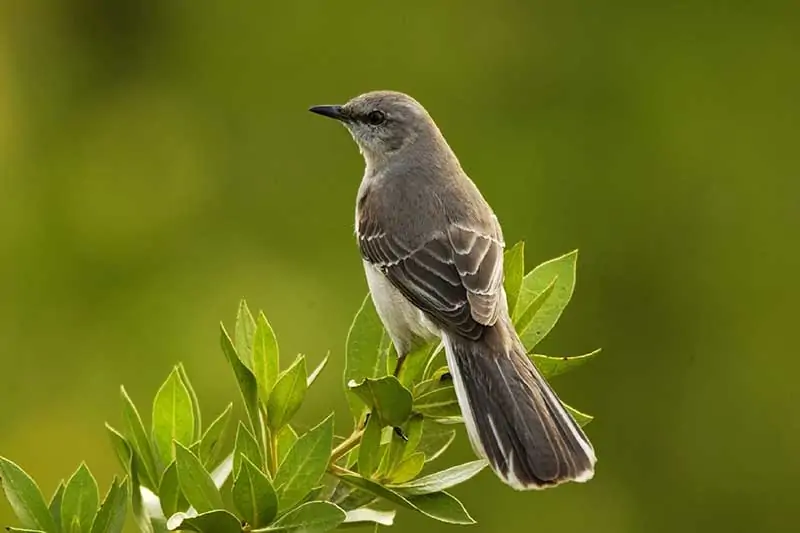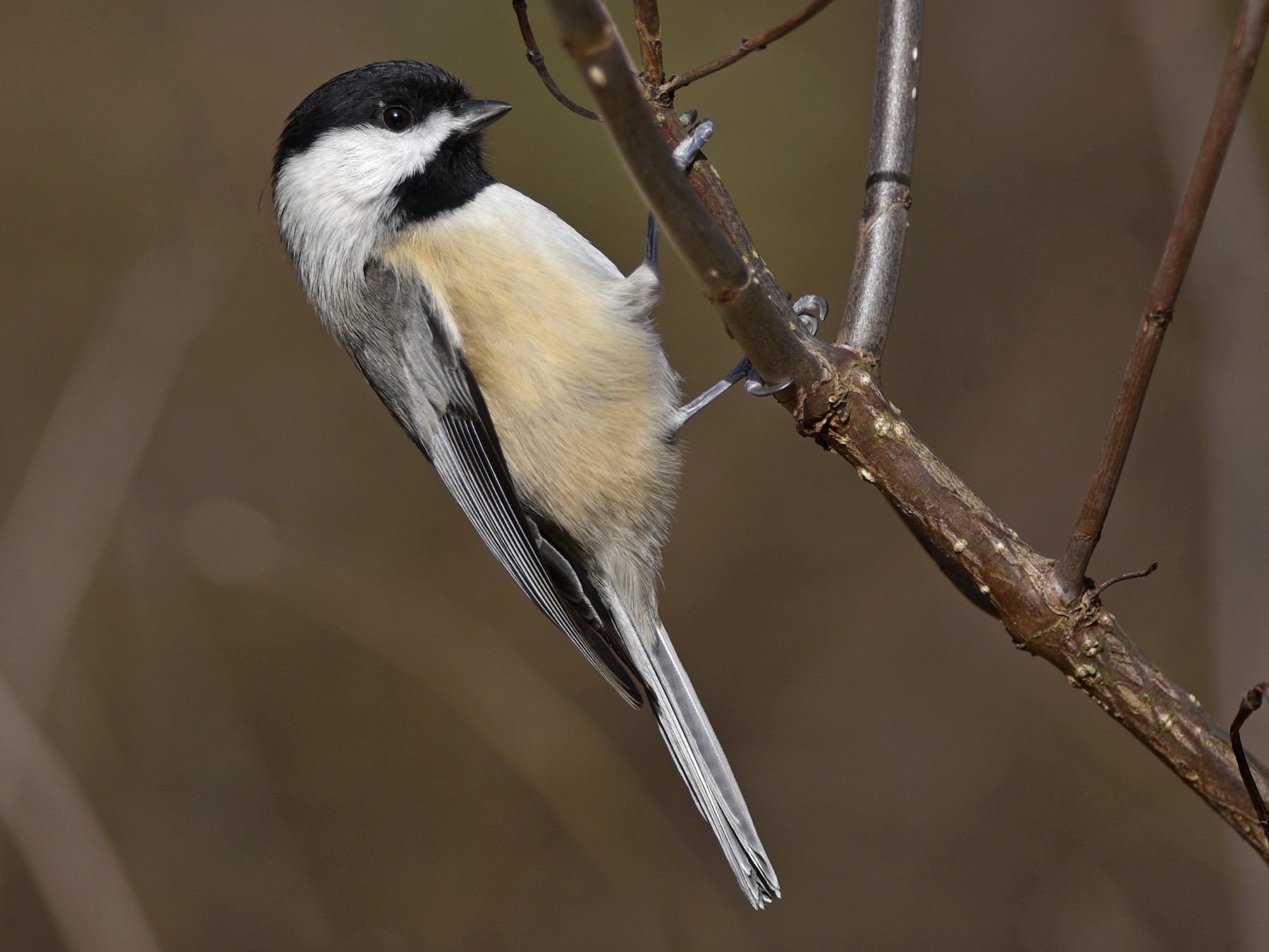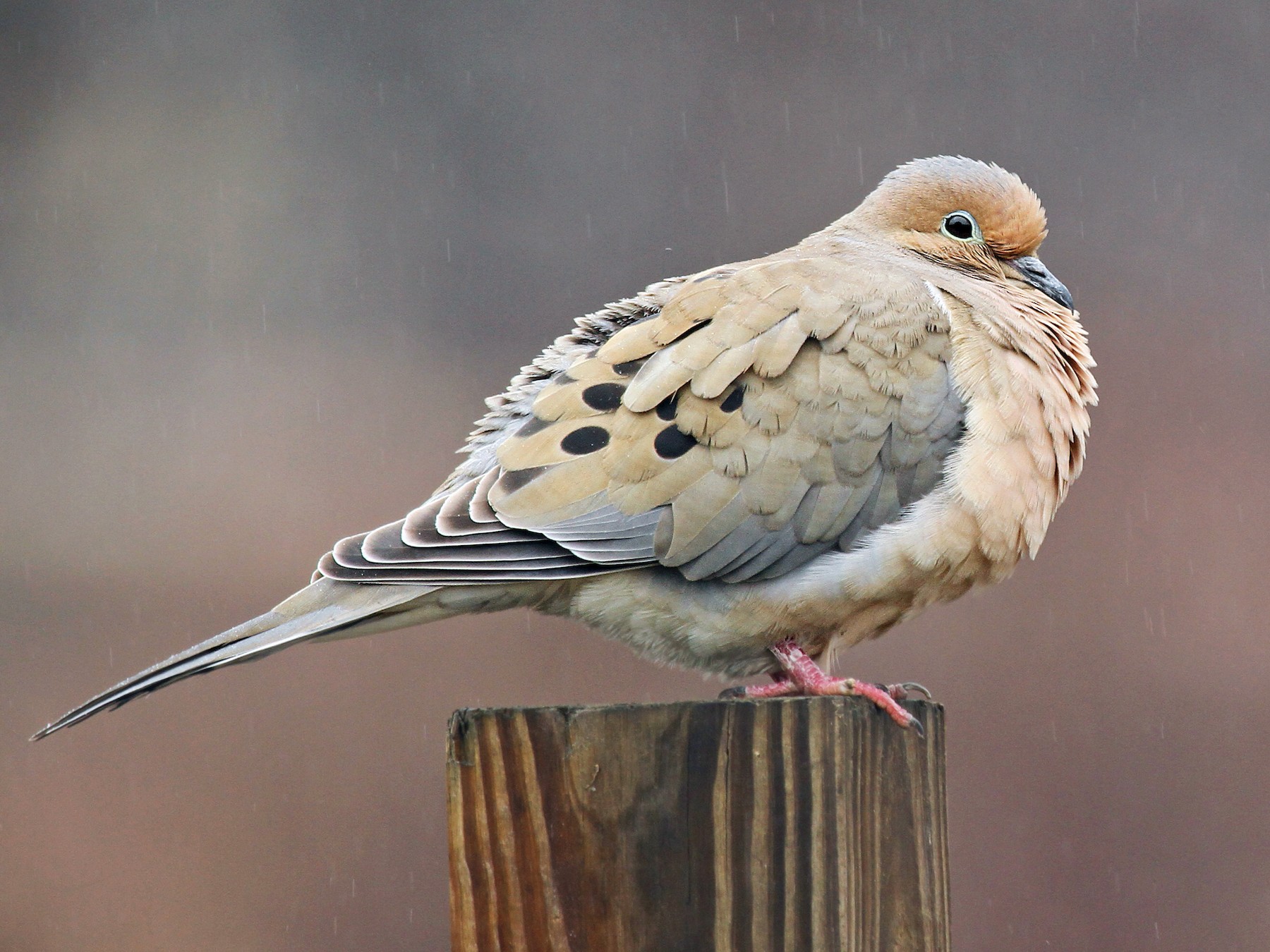Have you ever been curious about the species of birds frequenting your Arkansas backyard?
This guide will aid you in identifying these feathered visitors both visually and audibly, and inform you about the seasons when they’re most likely to be seen in Arkansas. Additionally, you can obtain a complimentary identification chart featuring the most common backyard birds in Arkansas for easy printing.
Birds that visit Arkansas backyards all year round include the Northern Cardinal, Blue Jay, Carolina Chickadee, Mourning Dove, Carolina Wren, American Crow, Tufted Titmouse, Northern Mockingbird, Red-bellied Woodpecker, Downy Woodpecker, American Robin, House Sparrow, Red-winged Blackbird, Eastern Bluebird, European Starling, House Finch, White-breasted Nuthatch, Pileated Woodpecker, Eastern Meadowlark, Pine Warbler, and the Chipping Sparrow.
Summer visitors to Arkansas backyards consist of the Indigo Bunting, Brown-headed Cowbird, Ruby-throated Hummingbird, Summer Tanager, Barn Swallow, and the Eastern Kingbird.
In the winter, you may spot the White-throated Sparrow, Dark-eyed Junco, Northern Flicker, American Goldfinch, Purple Finch, and the Yellow-rumped Warbler in your Arkansas backyard.
These are the most frequently seen backyard birds in Arkansas that could grace your garden or bird feeders. These species are the ones most regularly reported by bird enthusiasts on ebird in the state’s checklists.
Top 33 Backyard Birds in Arkansas
1. Northern Cardinal
Northern Cardinals, the most commonly sighted birds in Arkansas, can be observed throughout the year. They make appearances in 66% of summer checklists and 59% of winter checklists submitted by bird enthusiasts in the state.
The eye-catching male Northern Cardinal, with its fiery red plumage and black facial accents, offers a breathtaking sight, particularly when set against a snowy winter backdrop. They also boast red crests and beaks.
Female Cardinals, while slightly less vibrant, still draw attention with their brownish hues, distinct brown crest, red accents, and red beaks.
Cardinalis cardinalis Length: 8.3-9.1 in (21-23 cm) Weight: 1.5-1.7 oz (42-48 g) Wingspan: 9.8-12.2 in (25-31 cm)
Northern Cardinals inhabit the eastern half of the US, extending as far west as Arizona in some southern states.
Northern Cardinals can be found amid dense vegetation, where they forage for seeds, fruits, and insects. They are known to exhibit aggressive behavior towards their own reflections during the breeding season as they fiercely guard their territories.
To draw Northern Cardinals into your backyard, fill feeders with sunflower seeds, peanut hearts, millet, and milo. They will feed from large tube feeders, hoppers, platform feeders, or even food strewn on the ground.
Remember, Arkansas is also home to many other red bird species that you can spot.
2. Blue Jay
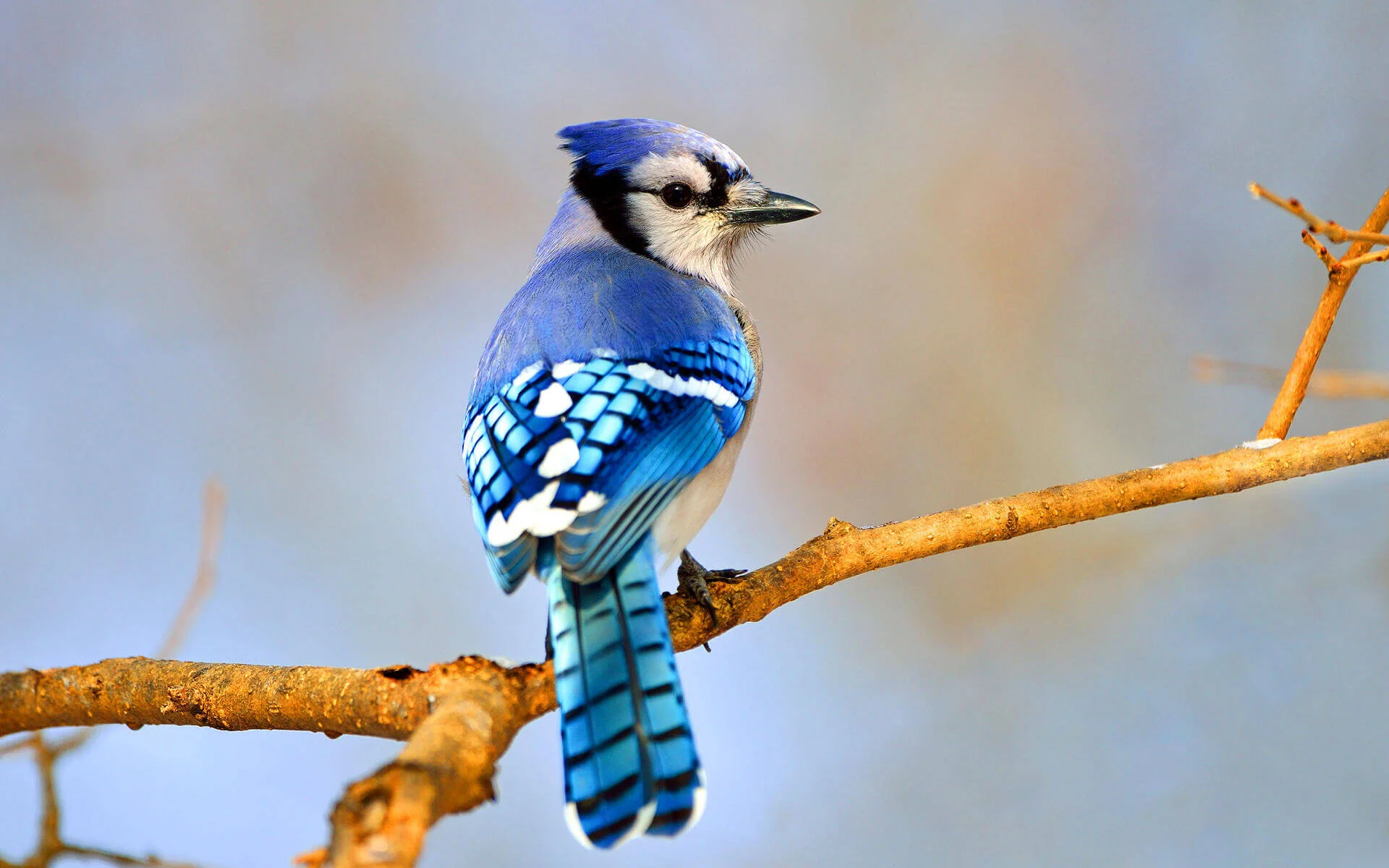
Blue Jays are a year-round feature in Arkansas, appearing in 51% of summer and 44% of winter bird watchers’ checklists for the state.
Recognizable for their large size and vibrant colors, Blue Jays sport a notable blue crest, a mix of blue and black on their back, and white bellies.
Cyanocitta cristata Dimensions: 9.8-11.8 inches (25-30 cm) long Weight: Between 2.5 and 3.5 ounces (70-100 g) Wingspan: Ranges from 13.4 to 16.9 inches (34-43 cm)
These vocal birds are residents of eastern US states and Southern Canada throughout the year, with only a minor proportion migrating west for the winter.
Blue Jays, often seen moving in family groups, are primarily acorn eaters and thus commonly inhabit oak-rich forests. They are also frequently sighted near backyard feeders. Their diet is diverse, including not only acorns, but insects, nuts, seeds, and grains. Occasionally, they may also prey on eggs or nestlings.
Being larger birds, Blue Jays have a preference for swooping in, grabbing a peanut or sunflower seed, and retreating to feed. They favor platform or tray feeders that allow for a swift departure.
To draw Blue Jays into your backyard, provide peanuts, sunflower seeds, and suet on open tray or hopper feeders mounted on a post. A birdbath will also be a welcomed addition.
3. Carolina Chickadee
Throughout the year, Carolina Chickadees can be seen in Arkansas. They show up on 40% of summer bird watching checklists and 48% in winter.
Carolina Chickadees are small birds characterized by their large heads, black caps and throats, white faces and bellies, and soft grey backs, wings, and tails.
Their appearance closely mirrors that of the Black-capped Chickadee, and where their habitats overlap, the two species have been known to interbreed.
Poecile carolinensis Size: Between 3.9 and 4.7 inches (10-12 cm) in length Weight: Around 0.3 to 0.4 ounces (8-12 g) Wingspan: Ranges from 5.9 to 7.9 inches (15-20 cm)
Carolina Chickadees inhabit forested regions, parks, and backyards in the eastern and southeastern United States all year round.
To invite Carolina Chickadees to your backyard, consider filling your feeders with black oil sunflower seeds, nyjer seeds, suet, or peanuts. They’re not picky about the type of feeder they use, so tube feeders, suet cages, or platform feeders all work well. Additionally, they have been known to nest in specially prepared nest boxes or tubes.
4. White-throated Sparrow
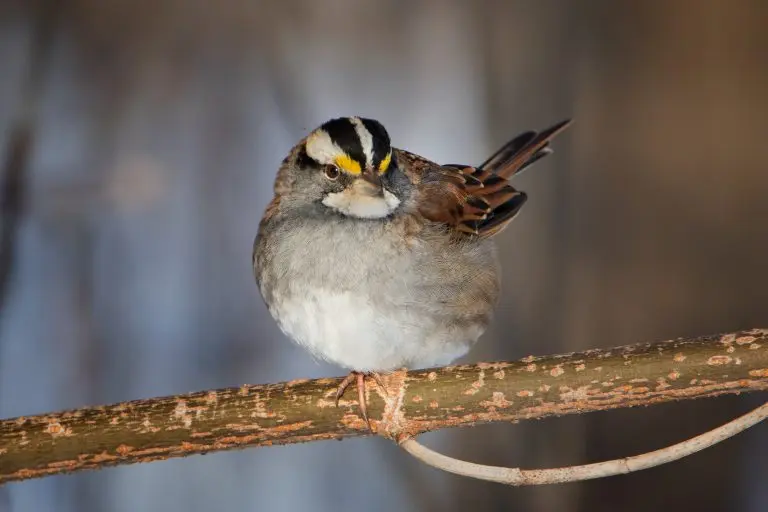
In the winter season, White-throated Sparrows are a common sight in Arkansas, appearing in 46% of bird watchers’ winter checklists. They are generally observed from October through mid-May.
White-throated Sparrows are characterized by their unique black and white striped head, a brightly white throat, and a splash of yellow between their eyes and beak. Their backs are brown while their underparts are gray.
Zonotrichia albicollis Size: Ranges from 6.3 to 7.1 inches (16-18 cm) in length Weight: Approximately 0.8 to 1.1 ounces (22-32 g) Wingspan: Spans between 7.9 and 9.1 inches (20-23 cm)
These sparrows are migratory in nature, primarily breeding in Canada and then journeying south during the winter to the eastern and southern regions of the United States and the Pacific Coast.
White-throated Sparrows can typically be found on the ground in forests and woods, as well as along the borders of wooded areas, often in sizable flocks.
Their diet primarily consists of seeds from grasses and weeds, and various fruits like grape, sumac, mountain ash, blueberry, blackberry, and dogwood. During the summer, they also consume a significant amount of insects found on the forest floor.
You can draw White-throated Sparrows to your backyard by offering millet and black oil sunflower seeds on flat, platform-style feeders.
5. Mourning Dove
Mourning Doves are year-round residents of Arkansas, appearing more frequently from April to September. They show up on 46% of summer checklists and 30% of winter ones submitted by state bird watchers.
These birds have an elegant silhouette, with small heads, robust bodies, and elongated tails. Their soft brown plumage, marked with black spots on the wings, makes them quite distinctive. Males tend to be slightly heavier than females.
Zenaida macroura Length: 9.1-13.4 in (23-34 cm) Weight: 3.0 -6.0 oz (96-170 g) Wingspan: 17.7 in (45 cm)
Mourning Doves are widespread across the lower 48 states, remaining all year round. However, those residing in the northern Midwest and southern Canada may migrate after the breeding season.
These doves are often spotted perched on telephone wires or scavenging for seeds on the ground in grasslands, fields, and backyards. They also frequent open areas or edges of woodlands.
If you want to attract Mourning Doves to your backyard, consider spreading millet on the ground or on platform feeders. They’re also quite fond of black sunflower seeds, nyjer, cracked corn, and peanut hearts.
6. Dark-eyed Junco
Dark-eyed Juncos, a variety of sparrow, showcase different hues based on their geographical location. Predominantly, they flaunt a slate tone in the east and a blend of black, white, and brown in the west.
Junco hyemalis Dimensions: 5.5-6.3 in (14-16 cm) long Weight: 0.6-1.1 oz (18-30 g) Wingspan: 7.1-9.8 in (18-25 cm)
Dark-eyed Juncos inhabit the northeastern and western United States, along with the Appalachian Mountains, throughout the year. However, those breeding in Canada and Alaska undertake a southward migration to the United States during winter.
These birds are usually seen in open and semi-wooded areas, often foraging on the ground, and they are a common sight across the continent.
To attract Dark-eyed Juncos to your backyard, use a variety of seeds like black oil sunflower seeds, nyjer, cracked corn, millet, and peanuts. Dispensing them on platform feeders or directly on the ground is the most effective method.
7. Carolina Wren
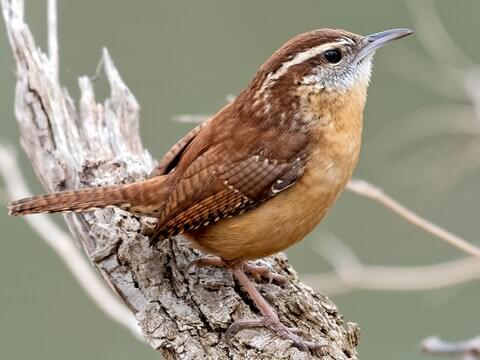
Carolina Wrens can be observed year-round in Arkansas, showing up in 42% of summer and 38% of winter checklists, as reported by bird watchers in the state. They are non-migratory birds.
Carolina Wrens are somewhat elusive birds, boasting a dark brown upper body and a lighter brown underside. They are marked by a white streak above their eyes and an erect tail, and are known for their distinctive ‘teakettle’ song.
Thryothorus ludovicianus Length: 4.7-5.5 in (12-14 cm) Weight: 0.6-0.8 oz (18-22 g) Wingspan: 11.4 in (29 cm)
Carolina Wrens inhabit the eastern and southeastern regions of the United States all year round.
They can be found in wooded areas or places with thick vegetation, and they are known to visit backyard feeders.
To attract Carolina Wrens to your backyard, you can use suet feeders, hulled sunflower seeds, or peanut hearts. These can be placed in large tube feeders or on platform feede
8. American Crow
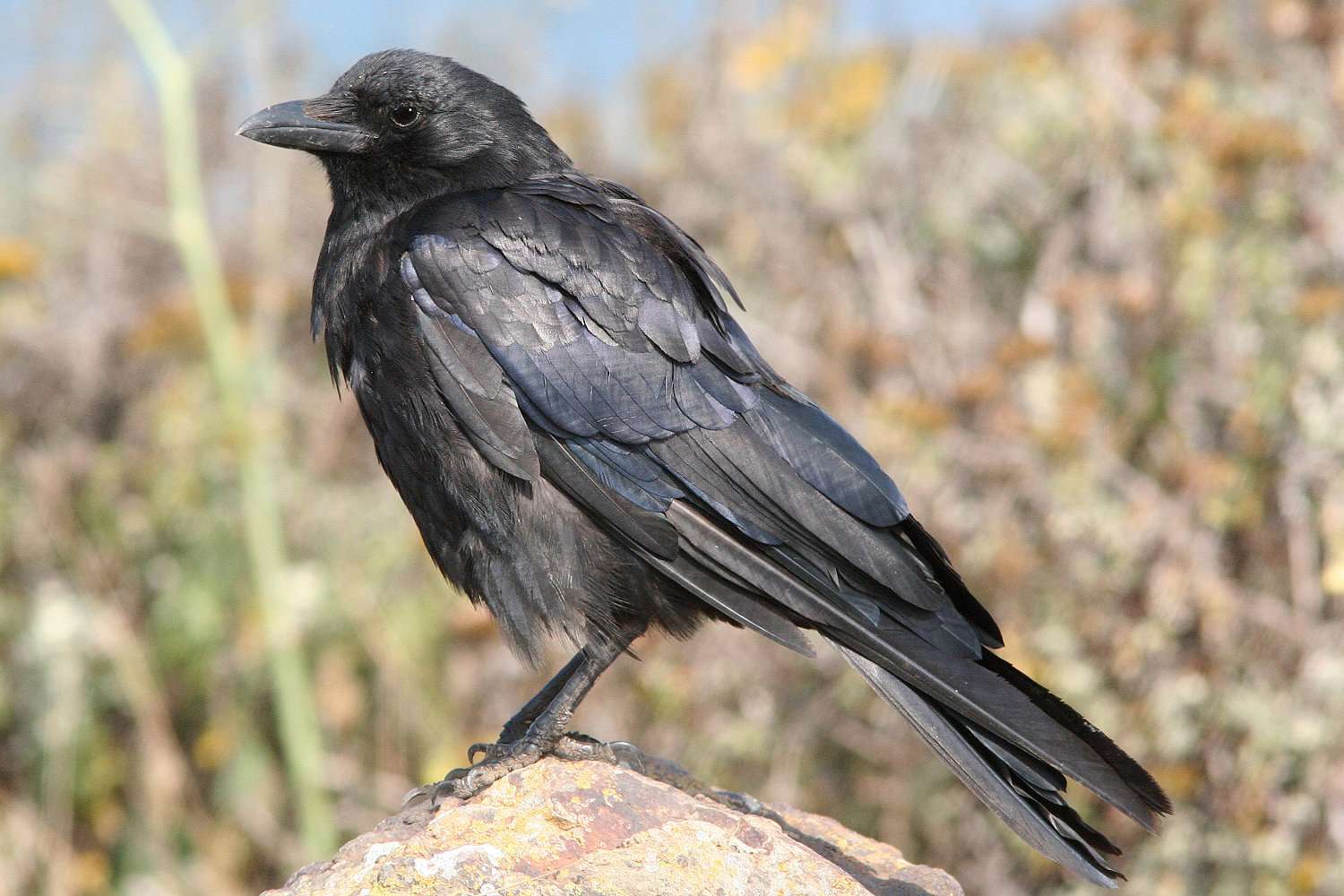
American Crows are a common sight in Arkansas throughout the year, being spotted in about 46% of both summer and winter bird watching checklists for the state.
These birds are all-black in color and are known for their distinct, raspy cawing sounds.
Corvus brachyrhynchos Length: 15.8-20.9 in (40-53 cm) Weight: 11.2-21.9 oz (316-620 g) Wingspan: 33.5-39.4 in (85-100 cm)
American Crows can be found throughout most of the contiguous United States and the Pacific coast of Canada and Alaska all year round. However, those residing in Canada and the northern Midwest tend to migrate south during the winter.
These birds are quite versatile, thriving in various habitats such as forests, fields, beaches, and even urban areas.
With a diverse diet, American Crows feed on earthworms, insects, seeds, and fruits found on the ground. They also eat fish, juvenile turtles, mussels, clams, and occasionally, the eggs and younglings of other bird species.
During the winter, American Crows form large, noisy communal roosts that can contain up to two million birds.
To attract American Crows to your backyard, you can scatter peanuts. However, beware as they can also be attracted to garbage or pet food left out, which can potentially become a nuisance.
9. Tufted Titmouse
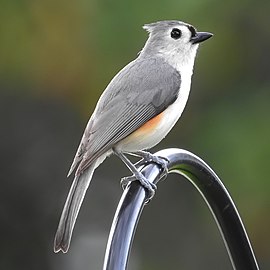
Tufted Titmice make Arkansas their home throughout the year, showing up in approximately 43% of both summer and winter bird-watching checklists.
These birds are easily recognizable by their grey crest, large eyes, and bodies which are grey on top and white underneath. They are often seen mingling with chickadees, nuthatches, and woodpeckers.
Baeolophus bicolor Length: 5.5-6.3 in (14-16 cm) Weight: 0.6-0.9 oz (18-26 g) Wingspan: 7.9-10.2 in (20-26 cm)
The Tufted Titmouse is a resident bird in the eastern and southeastern regions of the United States.
These birds can be found in woodlands and parks, and are frequent visitors to backyard feeders. They are quite assertive birds and are known to push smaller birds aside to get their share of the food.
Their diet is predominantly insect-based during the summer, with a preference for caterpillars, beetles, ants, wasps, as well as spiders and snails. They also enjoy seeds, nuts, and berries, and are known to store shelled seeds for later consumption.
To attract Tufted Titmice to your backyard, fill your tube feeders or suet cages with sunflower seeds, suet, and peanuts. They are also likely to feed from platform feeders. For those interested in attracting a breeding pair, consider installing a nest box.
10. Northern Mockingbird
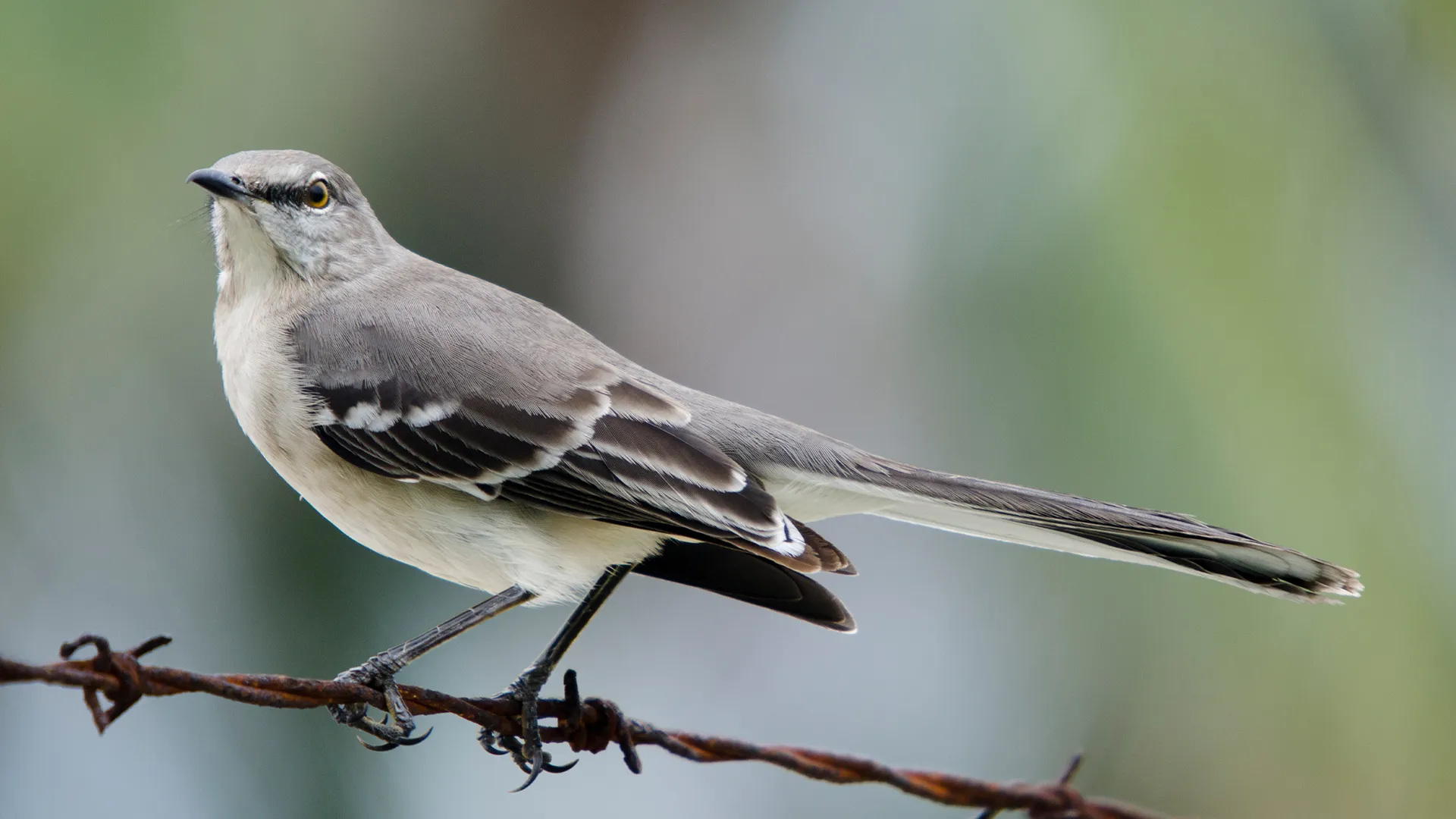
Northern Mockingbirds are permanent residents in Arkansas, making an appearance in 36% of summer bird-watching checklists and 26% of winter ones.
These medium-sized songsters have compact heads and elongated tails. They sport a gray-brown plumage, which is slightly lighter on their underparts, and two distinct white wingbars that become noticeable when they take flight.
Mimus polyglottos Length: 8.3-10.2 in (21-26 cm) Weight: 1.6-2.0 oz (45-58 g) Wingspan: 12.2-13.8 in (31-35 cm)
Northern Mockingbirds are non-migratory birds that can be seen throughout the lower 48 states and southern parts of Canada.
Usually spotted alone or in pairs, these birds are known for their territorial behavior. A male mockingbird is a skilled mimic, capable of learning around 200 different songs in its lifetime. They can sing tirelessly, filling the day and often the night with their melodies.
To encourage more Northern Mockingbirds to visit your backyard, consider planting trees or shrubs that produce berries, such as hawthorns, mulberries, and blackberry brambles. While they don’t frequently visit feeders, they are drawn to open lawn areas.
11. Indigo Bunting
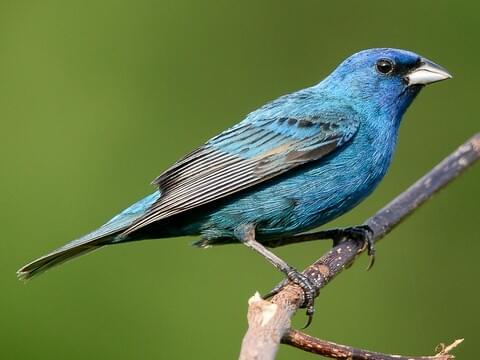
Indigo Buntings are commonly sighted in Arkansas during the summer months, appearing in 40% of bird-watching checklists. They are predominantly observed from April to October, although a few remain throughout the year.
Indigo Buntings are small-sized birds. The males flaunt a vibrant blue plumage with black streaks on their wings and tail, while females display a brown color.
Passerina cyanea Length: 4.7-5.1 in (12-13 cm) Weight: 0.4-0.6 oz (12-18 g) Wingspan: 7.5-8.7 in (19-22 cm)
Indigo Buntings embark on long migrations from their breeding territories in the eastern US, southeastern Canada, and southern US to their winter habitats in Florida, Central and South America, and the Caribbean.
These birds can often be spotted in fields filled with weeds and shrubby areas, where they forage for seeds and insects.
You can attract Indigo Buntings to your backyard by providing small seeds such as nyjer and thistle.
12. Red-bellied Woodpecker

Red-bellied Woodpeckers are regularly seen throughout the year in Arkansas, appearing in 38% of summer bird-watching checklists and 41% of winter ones.
Despite their name, Red-bellied Woodpeckers can often be confused with Red-headed Woodpeckers due to their red caps. However, they are considerably smaller. Female Red-bellied Woodpeckers don’t have the red cap, only displaying red at the back of their heads.
They have a faintly red belly, which can be difficult to discern, but they feature the standard black and white woodpecker patterns on their backs.
Melanerpes carolinus Length: 9.4 in (24 cm) Weight: 2.0-3.2 oz (56-91 g) Wingspan: 13.0-16.5 in (33-42 cm)
Native to the eastern states of the US, Red-bellied Woodpeckers are non-migratory.
These woodpeckers have a varied diet, consuming insects, spiders, grass seeds, fruits, and nuts. Occasionally, they’ll also prey on nestlings. They tend to nest in dead trees and often reuse the same nest each year, laying 4-5 white eggs on a bed of wood chips.
The Red-bellied Woodpecker has a tongue that extends 2 inches beyond its beak, which is barbed at the tip and coated in sticky saliva, aiding in the capture of prey from deep within crevices.
These woodpeckers are frequently spotted at bird feeders, particularly in areas near woods. They produce a distinctive, loud rolling call, often announcing their presence audibly before they are visually spotted.
13. Downy Woodpecker
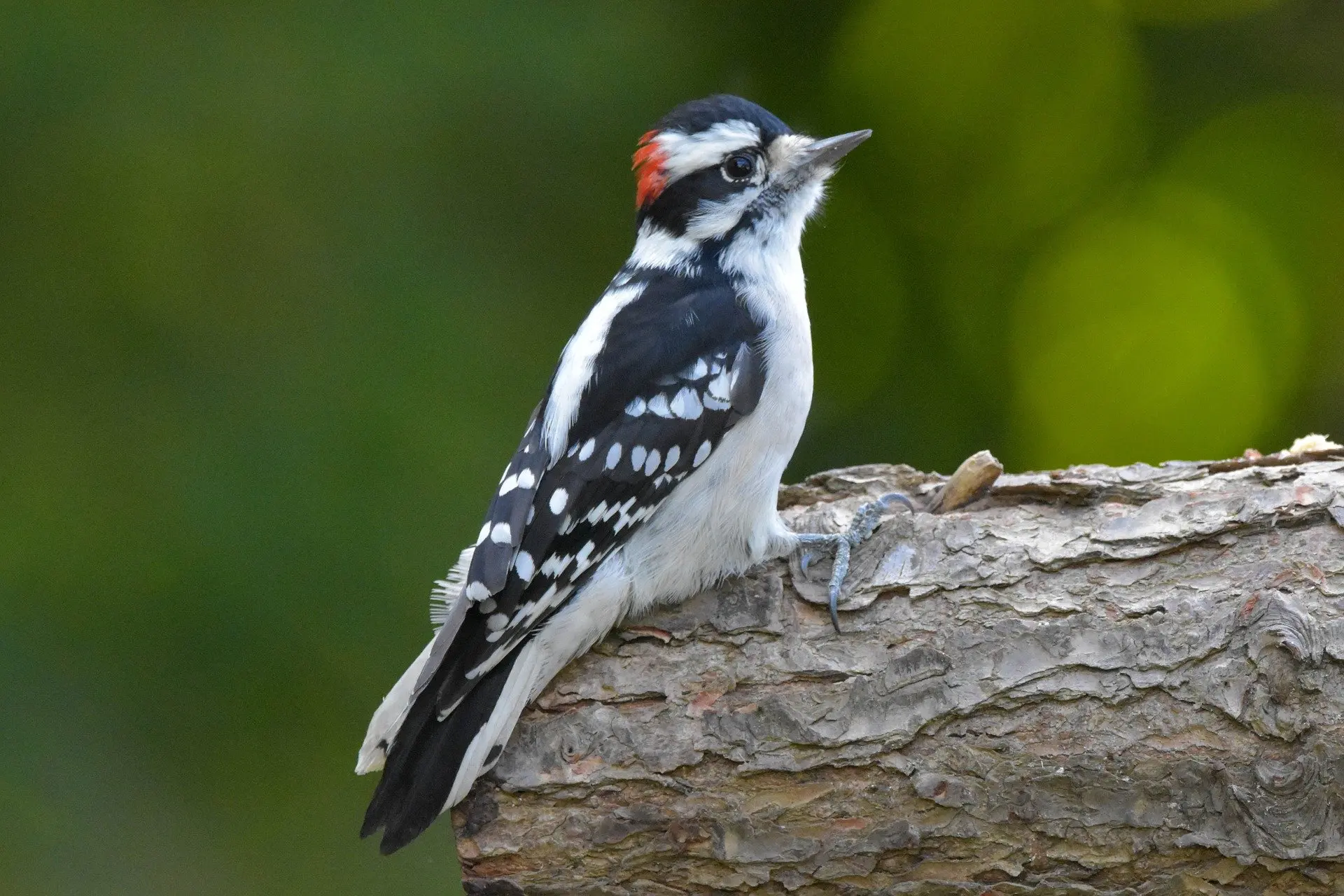
Downy Woodpeckers are year-round residents in Arkansas, appearing in 27% of summer bird-watching checklists and 36% of those compiled in the winter.
These small birds frequent backyard feeders and are commonly seen in the company of other bird species like chickadees and nuthatches. They bear black and white markings and a red patch at the back of their heads. Although they bear a resemblance to the larger Hairy Woodpecker, their smaller size helps distinguish them.
Dryobates pubescens Length: 5.5-6.7 in (14-17 cm) Weight: 0.7-1.0 oz (21-28 g) Wingspan: 9.8-11.8 in (25-30 cm)
Non-migratory, Downy Woodpeckers can be found in most American states and Canadian provinces, with the exception of the northernmost parts of Canada.
These birds habitually dwell in wooded areas, alongside streams, in city parks, and residential backyards. They feed mainly on insects and beetle larvae but will also consume berries, acorns, and grains.
To draw Downy Woodpeckers into your backyard, provide them with their preferred suet treat. They’ll also eat black oil sunflower seeds, millet, and peanuts if placed on platform feeders.
With the help of this guide, you should be able to identify any woodpecker species you encounter in Arkansas.
14. American Robin

American Robins are year-round inhabitants of Arkansas, being observed in 33% of summer and 31% of winter bird-watching checklists for the area.
A familiar sight on lawns as they forage for earthworms, American Robins sport black heads and backs contrasted by red or orange chests. During winter, they tend to nest in trees, making them more noticeable in your backyard come spring.
Turdus migratorius Length: 7.9-11.0 in (20-28 cm) Weight: 2.7-3.0 oz (77-85 g) Wingspan: 12.2-15.8 in (31-40 cm)
American Robins occupy most of the lower 48 states, the western coast of Canada, and Alaska. However, those that nest in inland Alaska and Canada migrate south during winter.
These birds adapt well to diverse habitats such as woodlands, forests, mountains, fields, parks, and lawns. Their diet consists of earthworms, insects, snails, and a variety of fruits.
To invite American Robins into your backyard, offer sunflower seeds, suet and peanut hearts, fruit, and mealworms. Platform feeders or simply scattering food on the ground works best. Additionally, consider planting native berry-producing plants like juniper, sumac, hawthorn, and dogwood.
15. House Sparrow
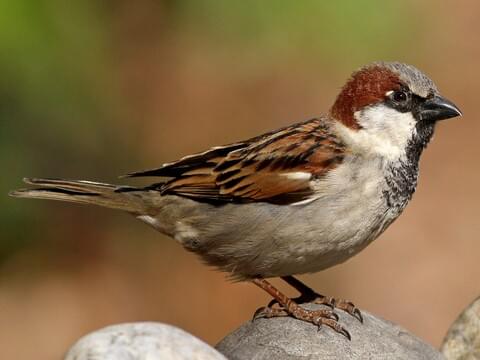
House Sparrows, an introduced species in Arkansas, are year-round residents here, appearing in 21% of summer bird-watching checklists and 15% of winter ones.
This foreign species has thrived and become one of the most prevalent birds. With their gray and brown heads, white cheeks, black and brown backs, and gray bellies, they are easily recognizable.
Passer domesticus Length: 5.9-6.7 in (15-17 cm) Weight: 0.9-1.1 oz (27-30 g) Wingspan: 7.5-9.8 in (19-25 cm)
House Sparrows are year-round inhabitants of the US and Southern Canada.
These birds are commonly found near human dwellings and buildings. Remarkably tame, they may even feed directly from your hand.
Their diet consists largely of grains and seeds, as well as discarded human food. Although considered a nuisance due to their non-native status, they frequent backyards even when not intentionally fed.
To attract House Sparrows to your backyard feeders, use a variety of birdseeds, such as millet, corn, and sunflower seeds.
Despite their often overlooked brown plumage, once you become familiar with these birds, they can captivate your attention. So, immerse yourself in studying all the brown birds of Arkansas.
16. Red-winged Blackbird

Red-winged Blackbirds are a year-round sight in Arkansas, featuring in 28% of bird-watching checklists during the summer and 17% during the winter.
These birds are quite commonplace and easy to identify due to their predominantly black plumage, offset by vibrant red-orange patches on their wings. The female of the species, however, is more subdued with a streaky brown appearance.
Agelaius phoeniceus Length: 6.7-9.1 in (17-23 cm) Weight: 1.1-2.7 oz (32-77 g) Wingspan: 12.2-15.8 in (31-40 cm)
Red-winged Blackbirds inhabit the lower 48 states throughout the year, as well as the Pacific Coast of British Columbia. Those breeding in Canada and some northern US states journey south for the winter.
Frequently perched on telephone wires, male Red-winged Blackbirds are known for their territorial nature during breeding season, defending their nests so aggressively they’ve been known to attack people who venture too close. In the winter, they form impressively large roosts, numbering in the millions.
To draw Red-winged Blackbirds to your backyard, scatter mixed grains and seeds on the ground. They are also known to feed from large tube feeders or platform feeders.
Blackbirds represent a vast bird family with numerous members. Why not take the opportunity to familiarize yourself with all the blackbirds found in Arkansas?
17. Eastern Bluebird

Eastern Bluebirds are year-round residents of Arkansas, appearing in 25% of summer bird-watching checklists and 27% of winter ones.
These small thrushes have distinctive large, round heads, sizable eyes, and plump bellies. Males boast a deep blue color on their backs, contrasted by a reddish hue on their undersides. Females, on the other hand, display grayer tops with hints of blue in their wings and tails, and their breasts are a less vibrant shade of orange-brown.
Sialia sialis Length: 6.3-8.3 in (16-21 cm) Weight: 1.0-1.1 oz (28-32 g) Wingspan: 9.8-12.6 in (25-32 cm)
Eastern Bluebirds are year-round inhabitants of southeastern US states. However, those breeding in the northern US and southern Canada tend to migrate southwards.
These birds are often spotted in meadows, perched on wires, posts, or low-hanging branches while scouting for insects.
To attract Eastern Bluebirds to your backyard, consider providing mealworms and nest boxes, particularly if your yard is relatively open and expansive.
18. Brown-headed Cowbird
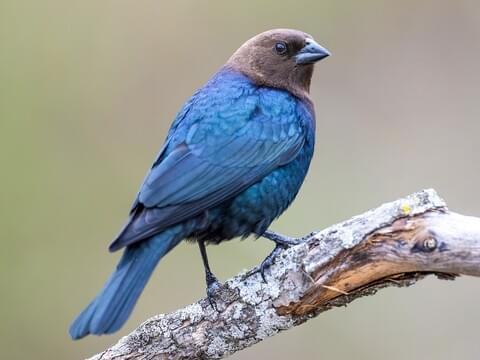
Brown-headed Cowbirds are often sighted in Arkansas from March through July, making an appearance in 28% of checklists during this period. Some, however, are year-round residents, showing up in 3% of winter checklists.
Male Brown-headed Cowbirds, larger than their female counterparts, flaunt black bodies, brown heads, and short tails. Females, on the other hand, are entirely brown with a hint of streaking.
Molothrus ater Length: 7.6-8.7 in (19-22 cm) Weight: 1.3-1.8 oz (42-50 g) Wingspan: 14.2 in (36 cm)
Brown-headed Cowbirds reside throughout the year in eastern and southern US states, as well as along the Pacific Coast. Those breeding in northern and western US states and Canada tend to migrate south when winter approaches.
These birds are often viewed as pests due to their parasitic breeding habits. They are known to destroy the eggs of smaller songbirds, replacing them with their own for the unsuspecting bird to unknowingly foster their offspring.
19. Ruby-throated Hummingbird

Ruby-throated Hummingbirds are common summer sightings in Arkansas, featuring in 25% of birdwatching checklists during this period. They begin to arrive in the state for breeding around March and typically depart by October, although some may linger until November or December.
These hummingbirds boast a vibrant green back and crown, contrasted with a gray-white belly. Males are distinguished by their dazzling red throats. In contrast, females lack the red hue on their throat and present green backs, white bellies, and a touch of brown on their crowns and sides.
Archilochus colubris Length: 2.8-3.5 in (7-9 cm) Weight: 0.1-0.2 oz (2-6 g) Wingspan: 3.1-4.3 in (8-11 cm)
As the solitary hummingbird species that breeds in eastern North America, Ruby-throated Hummingbirds embark on their migration over the Gulf of Mexico or through Texas towards Central America for the winter.
These hummingbirds start to arrive in the southernmost parts of their range in February, but may not reach northern states and Canada until May for breeding. Their migration back south typically begins in August and September.
Male Ruby-throated Hummingbirds are known to be territorial, aggressively protecting their chosen flowers and feeders. After mating, they don’t linger for long and may start their migration as early as August.
These petite birds are recognized for their rapid flight from one nectar source to another or for their adeptness at catching insects midair or from spider webs. Although they can sometimes be seen perched on small twigs, their short legs prevent them from walking, allowing only for a shuffle along a perch.
During summer, the best places to spot them are in flowering gardens or at the edges of woodlands. They are also frequently seen in urban areas, especially at nectar feeders.
To attract Ruby-throated Hummingbirds to your backyard, you can use homemade nectar. Additionally, shade-loving plants and vibrant hanging plants can also serve as effective lures.
20. European Starling

European Starlings, despite being an introduced species, are a year-round presence in Arkansas. Birdwatchers in the state report them in 25% of summer checklists and 23% of winter checklists.
Although not native, European Starlings have successfully established themselves as one of the most abundant songbird species. They are robust, black birds that exhibit a captivating iridescence in hues of purple, green, and blue.
Sturnus vulgaris Length: 7.9-9.1 in (20-23 cm) Weight: 2.1-3.4 oz (60-96 g) Wingspan: 12.2-15.8 in (31-40 cm)
The range of European Starlings covers the entirety of North America, with the exception of northern Canada and Alaska.
Their assertive demeanor has earned them a reputation as pests in some circles. Often observed in substantial, clamorous flocks, these birds can frequently be found congregated atop trees or soaring above fields.
European Starlings sustain themselves primarily on insects, including beetles, flies, caterpillars, earthworms, and spiders. They are also known to consume various fruits, such as cherries, holly berries, mulberries, Virginia Creeper, sumac, blackberries, as well as various grains and seeds.
To draw European Starlings to your backyard feeders, you can offer black oil sunflower seeds, suet, cracked corn, and peanuts.
21. Summer Tanager
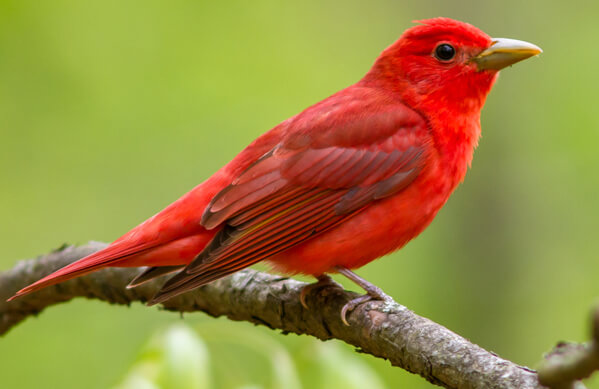
Summer Tanagers are often sighted in Arkansas during their breeding months from April to October, appearing in a quarter of all birdwatching checklists during this period.
The male Summer Tanagers stand out with their vibrant red plumage and hefty beaks. Females and young ones, on the other hand, exhibit predominantly yellow hues with a touch of green on their backs.
Piranga rubra Length: 6.7 in (17 cm) Weight: 1.1 oz (30 g)
Breeding in the southern and eastern states, Summer Tanagers migrate to Central and South America when winter arrives.
Summer Tanagers frequent open woodlands and are adept at capturing bees and wasps mid-flight for sustenance. They stun their prey by striking them against a branch and meticulously remove the stinger before consuming them.
To draw Summer Tanagers to your backyard, consider planting berry bushes and fruit trees.
22. House Finch
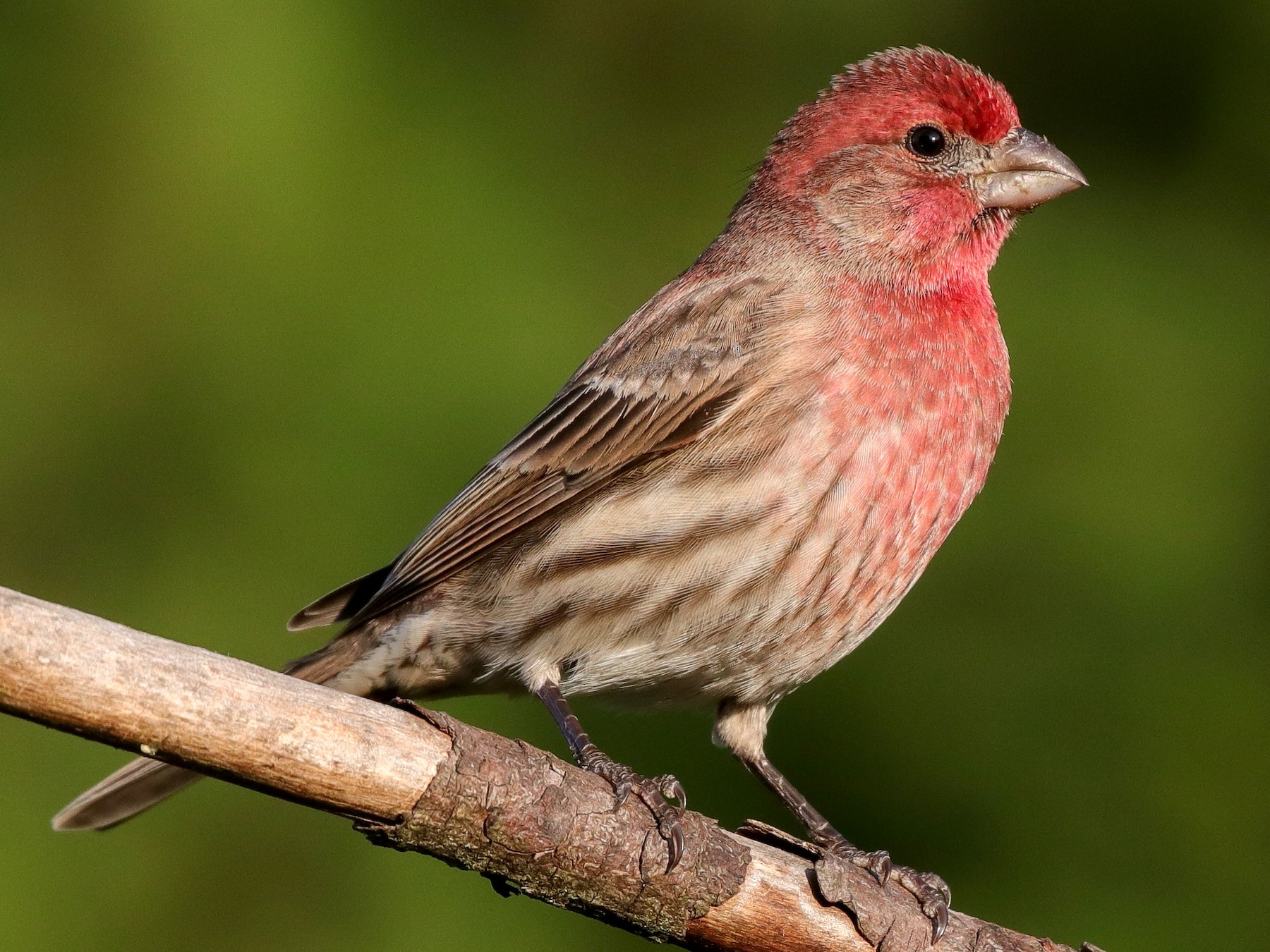
House Finches are permanent inhabitants of Arkansas throughout the year. They do not exhibit migratory patterns and are included in 20% of the summer and 22% of the winter checklists recorded by the state’s bird enthusiasts.
The male House Finches flaunt a vibrant red head and chest, while the rest of their bodies are predominantly streaked brown. The females, on the other hand, bear an all-over brown streaked coloration.
Haemorhous mexicanus Length: 5.1-5.5 in (13-14 cm) Weight: 0.6-0.9 oz (16-27 g) Wingspan: 7.9-9.8 in (20-25 cm)
Originally native to the western US, House Finches were introduced in the eastern parts of the country and have adapted exceptionally well, even outcompeting the Purple Finch.
These birds are commonly found in parks, farm lands, forest edges, and backyard feeders, usually in boisterous groups that are hard to overlook.
To attract House Finches to your backyard, consider offering black oil sunflower seeds or nyjer seeds in tube feeders or platform feeders.
23. Barn Swallow
.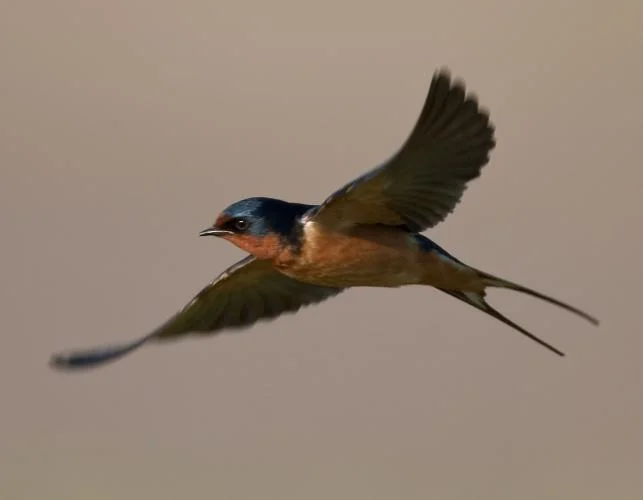
Barn Swallows are present in Arkansas during their breeding season and feature in 21% of the summer bird-watching checklists. These birds are generally observed between March and November.
Barn Swallows are petite in size, showcasing a vibrant deep-blue color on their back, wings, and tail, and a reddish-brown hue on their face and underside. Their tail features elongated outer feathers forming a pronounced fork. The dark shade of their back can sometimes make them appear black-and-white.
Hirundo rustica Length: 5.9-7.5 in (15-19 cm) Weight: 0.6-0.7 oz (17-20 g) Wingspan: 11.4-12.6 in (29-32 cm)
Barn Swallows breed in the US and Canada before migrating to Central and South America. These birds are typically found soaring above meadows, farms, and fields in search of insects. They are known to construct mud nests on man-made structures such as barns.
To attract Barn Swallows to your backyard, consider installing nest boxes or cups. These birds might also feed on crushed eggshells placed on a platform feeder.
24. Northern Flicker

Northern Flickers are sighted year-round in Arkansas, but their prevalence increases during winter due to the influx of birds migrating from their northern breeding areas. They are noted in 9% of summer bird-watching checklists and in 23% of winter ones.
These birds are large brown woodpeckers adorned with black spots and a distinctive white patch on their rump that becomes visible during flight. Male Northern Flickers also have a red patch at the back of their neck.
Depending on their region of origin, Northern Flickers showcase either red or yellow flashes in their wings and tails. Birds from the west are known as red-shafted, while those from the east are called yellow-shafted.
Colaptes auratus Length: 11.0-12.2 in (28-31 cm) Weight: 3.9-5.6 oz (110-160 g) Wingspan: 16.5-20.1 in (42-51 cm)
Northern Flickers are found all across the US throughout the year, while in Canada, they are mostly seen during the summer. Those that breed in Canada migrate south for the winter.
Their diet primarily consists of ants, beetles, fruits, and seeds, and it’s not uncommon to see them on the ground, using their curved bill to dig for food.
25. White-breasted Nuthatch

White-breasted Nuthatches are year-round residents of Arkansas, making appearances in 18% of bird-watchers’ summer checklists and 23% of winter ones.
These active small birds are characterized by their gray-blue backs and white faces and bellies, along with a distinguishing black cap. Often, they exhibit a chestnut hue on their lower bellies and beneath their tails.
Sitta carolinensis Length: 5.1-5.5 in (13-14 cm) Weight: 0.6-1.1 oz (18-30 g) Wingspan: 7.9-10.6 in (20-27 cm)
White-breasted Nuthatches inhabit the US and southern Canada throughout the year.
They can be found in a variety of settings such as deciduous forests, edges of woodlands, parks, and yards with trees or bird feeders. Their diet primarily consists of insects like beetles and their larvae, caterpillars, ants, and spiders.
Apart from insects, White-breasted Nuthatches also consume seeds and nuts, including acorns, hawthorns, sunflower seeds, and occasionally corn crops. They have a unique feeding habit of wedging large nuts and acorns into tree bark, then using their bills to crack or ‘hatch’ them open to access the seeds inside.
To attract White-breasted Nuthatches to your backyard, fill tube feeders or suet feeders with sunflower seeds and peanuts.
26. American Goldfinch
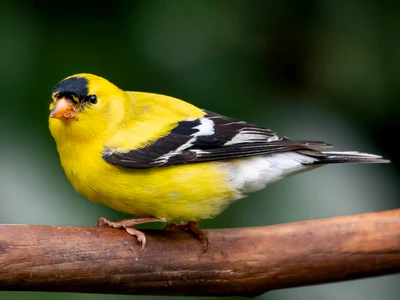
American Goldfinches are predominantly sighted in southern Arkansas during the winter months. However, a portion remains throughout the year in the northern part of the state. They are documented in 15% of the summer and 33% of the winter checklists collected by the state’s bird watchers.
These popular birds are easily identifiable due to the males’ striking yellow and black hues in the spring. The females, as well as the males during winter, exhibit more subdued brown tones.
Spinus tristis Length: 4.3-5.1 in (11-13 cm) Weight: 0.4-0.7 oz (11-20 g) Wingspan: 7.5-8.7 in (19-22 cm)
Most of North America serves as a habitat for American Goldfinches, with many of them residing in the same areas year-round. However, those that breed in Canada and the Midwest tend to migrate to the southern US states for the winter.
These birds frequent weedy fields and overgrown areas, foraging for sunflowers, thistles, and asters. They are also commonplace in suburban areas, parks, and backyards.
To attract American Goldfinches to your backyard, consider planting thistles and milkweed. They are known to visit a variety of bird feeders, showing a preference for sunflower seeds and nyjer seeds.
27. Purple Finch

Purple Finches are typically winter visitors in Arkansas, arriving as early as September and staying as late as May. The optimal time to spot them is between November and April, and they are noted in 7% of winter bird-watching checklists.
Male Purple Finches exhibit reddish-purple heads and chests, with their backs and wings showing more brown hues and their bellies being somewhat lighter. Females are streaked with brown all over. They closely resemble House Finches but tend to have a more pronounced red color, particularly on the upper part of their backs.
Haemorhous purpureus Length: 4.7-6.3 in (12-16 cm) Weight: 0.6-1.1 oz (18-32 g) Wingspan: 8.7-10.2 in (22-26 cm)
Purple Finches breed in Canada and migrate to eastern states during the winter. However, they can be found year-round in the northeastern regions and along the Pacific coast.
Purple Finches can be spotted in evergreen forests where they feed on seeds, as well as buds, nectar, and berries.
To attract Purple Finches to your backyard, consider providing black oil sunflower seeds.
28. Eastern Kingbirds
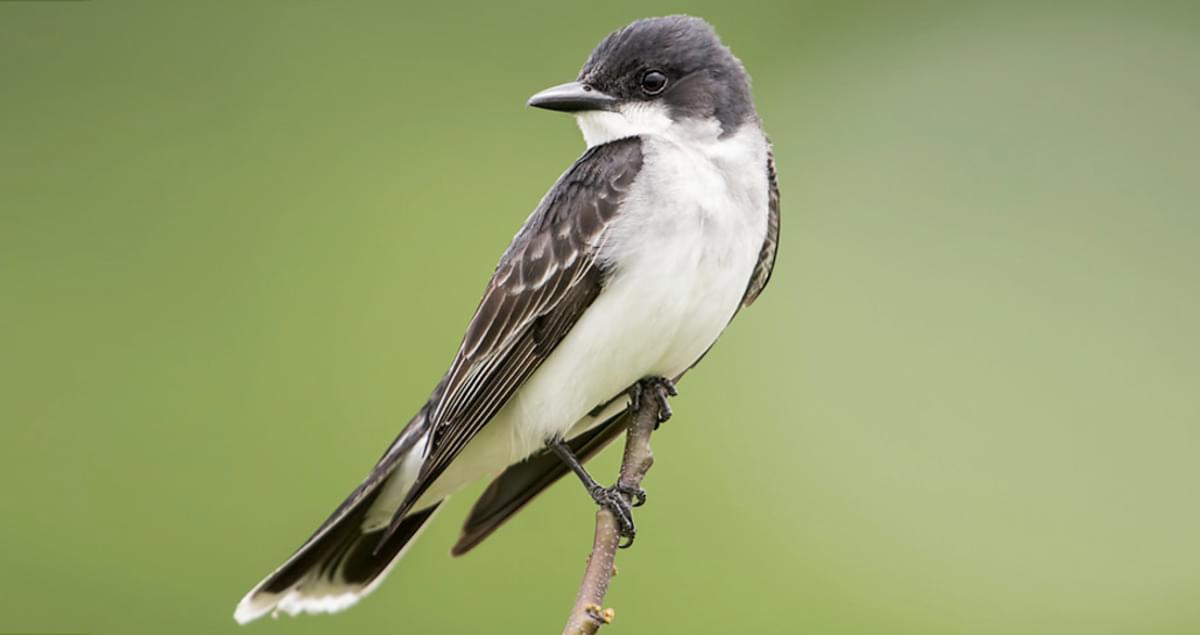
Eastern Kingbirds, medium-sized flycatchers with large heads, blackish backs, and white undersides, are usually seen in Arkansas from March to October during their breeding season. Their heads are a darker black, and their tails feature a white tip. They are recorded in 20% of birdwatching checklists during summer.
These birds, known as ‘kings’, exhibit aggression towards each other and other species in order to protect their nests. They possess a hidden crown of yellow, orange, or red feathers, which they display when feeling threatened or defending their nests.
Tyrannus tyrannus Length: 7.5-9.1 in (19-23 cm) Weight: 1.2-1.9 oz (33-55 g) Wingspan: 13.0-15.0 in (33-38 cm)
Eastern Kingbirds breed in the United States before migrating south to Central and South America for the winter season. Habitats that they typically breed in include fields, orchards, and forest edges, often choosing locations close to bodies of water such as rivers or lakes.
Their diet consists of insects caught in midair, such as bees, wasps, ants, beetles, crickets, grasshoppers, bugs, and flies. They are often seen perched above fields, waiting for insects to fly by. In addition to insects, they also consume fruit like serviceberries, cherries, blackberries, and elderberries.
To attract Eastern Kingbirds to your yard, consider planting native berry bushes and maintaining a variety of native plants that attract insects.
29. Pileated Woodpecker
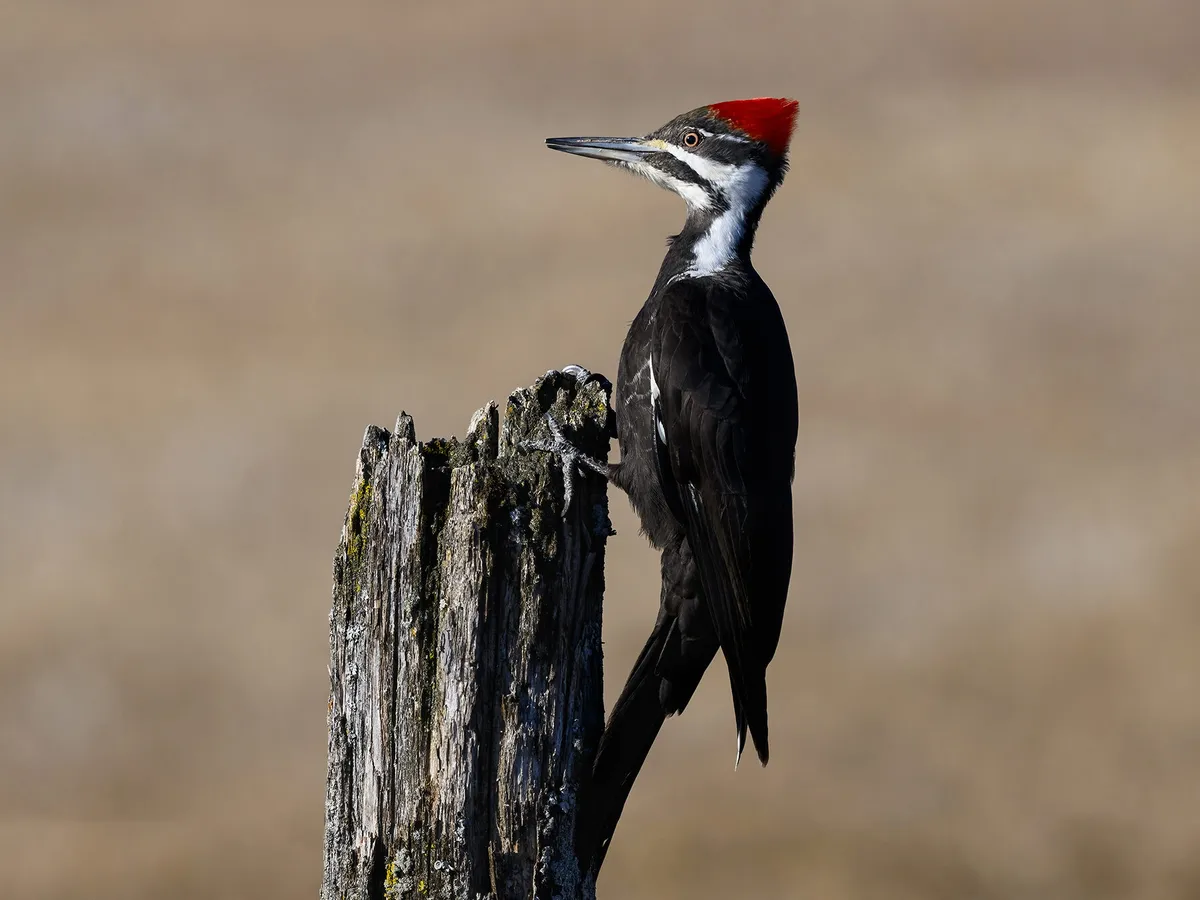
Pileated Woodpeckers, the largest species of woodpeckers in North America, can be observed throughout the year in Arkansas. These birds are noted in 14% of birdwatcher checklists in summer and 12% in winter.
These woodpeckers are easily recognizable by their prominent, fiery-red triangular crests. Their black bodies are adorned with a white stripe, and the white underside of their wings becomes visible during flight. A distinctive red stripe on the cheek marks the males of the species.
Dryocopus pileatus Length: 15.8-19.3 in (40-49 cm) Weight: 8.8-12.3 oz (250-350 g) Wingspan: 26.0-29.5 in (66-75 cm)
Pileated Woodpeckers reside throughout the year in the eastern United States, across Canada, and extending into the northwestern states of the US.
Their diet primarily consists of carpenter ants, which they forage from dead trees and fallen logs. They also feed on beetle larvae, termites, other insects, as well as fruits and nuts such as blackberries, sumac berries, dogwood, and elderberries. They are known for their loud, shrill calls and deep, resonant drumming.
To entice Pileated Woodpeckers to your backyard, consider using suet feeders that are equipped with tail props.
30. Yellow-rumped Warbler
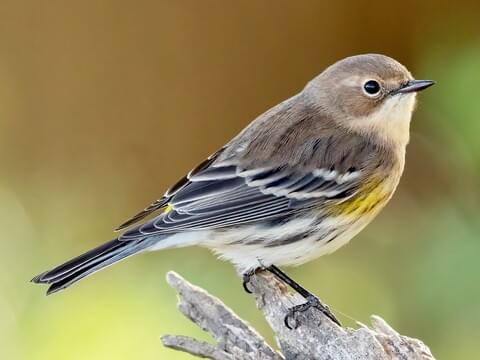
Yellow-rumped Warblers are winter visitors in Arkansas, typically making their appearance from September, with some remaining as late as May. However, the optimal period for observing them extends from October to April. These birds are noted in about 15% of the winter checklists compiled by the state’s bird enthusiasts.
Recognizable by their grey coloration and striking yellow accents on the face, flanks, and rump, along with white wing patches, Yellow-rumped Warblers are quite distinctive. Females may carry a slightly brown hue, and during winter, their plumage shifts to a paler brown, with the yellow on the rump and sides becoming more vibrant. By spring, they regain their bright yellow and gray tones.
Setophaga coronata Length: 4.7-5.5 in (12-14 cm) Weight: 0.4-0.5 oz (12-13 g) Wingspan: 7.5-9.1 in (19-23 cm)
These warblers primarily breed in Canada, as well as in select areas of the Rockies and Appalachian mountains. During their migratory journey, they are often observed in the Midwest, before settling for the winter in the southern and southwestern US, the Pacific Coast, and extending into Mexico and Central America.
Yellow-rumped Warblers favor coniferous forests, particularly during breeding season. In the winter, they are commonly found in open areas abundant with fruit-bearing shrubs. Their diet is seasonally varied: in the summer they primarily consume insects, while during migration and winter, they shift towards a fruit-based diet, particularly favoring bayberries and wax myrtles.
To draw Yellow-rumped Warblers to your backyard, consider offering sunflower seeds, suet, raisins, and peanut butter.
These vibrant and tuneful migratory birds are fleeting visitors, so make sure to spot all the warblers in Arkansas while they’re around.
31. Eastern Meadowlark
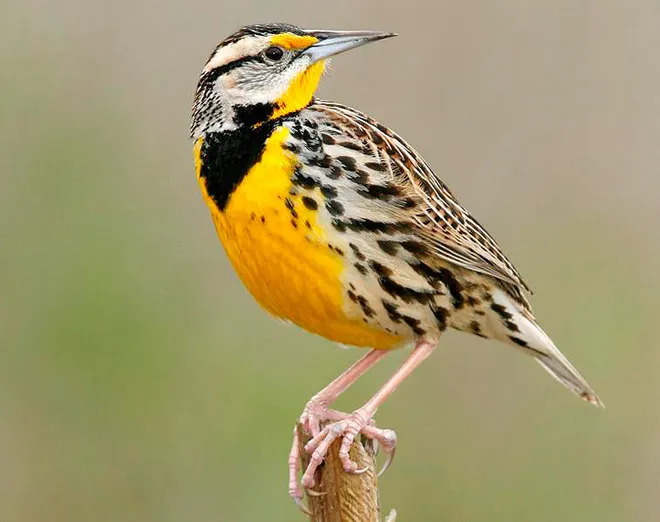
Eastern Meadowlarks, a species nearing threatened status, can be observed year-round in Arkansas, featuring in 13% of summer checklists and 10% of winter checklists for bird watchers in the state.
Sporting a medium size for songbirds, Eastern Meadowlarks showcase a bright yellow underside contrasting with their pale brown, black-marked backs. A characteristic black band runs across their chests.
Sturnella magna Length: 7.5-10.2 in (19-26 cm) Weight: 3.2-5.3 oz (90-150 g) Wingspan: 13.8-15.8 in (35-40 cm)
These birds inhabit the eastern states of the US throughout the year, with some extending their range to the Northeast and Canada for breeding before embarking on their southward migration.
The arrival of spring in the East is often marked by the melodious singing and expressive displays of Eastern Meadowlarks, although they are sadly nearing a threatened status.
Frequenting grasslands and prairies, these birds are typically seen foraging on the ground for insects. During winter, they form large flocks in fields to search for seeds.
Eastern Meadowlarks build remarkable ground nests, often crafting tunnels and roofs from woven grasses in an impressive display of avian architecture.
32. Pine Warbler
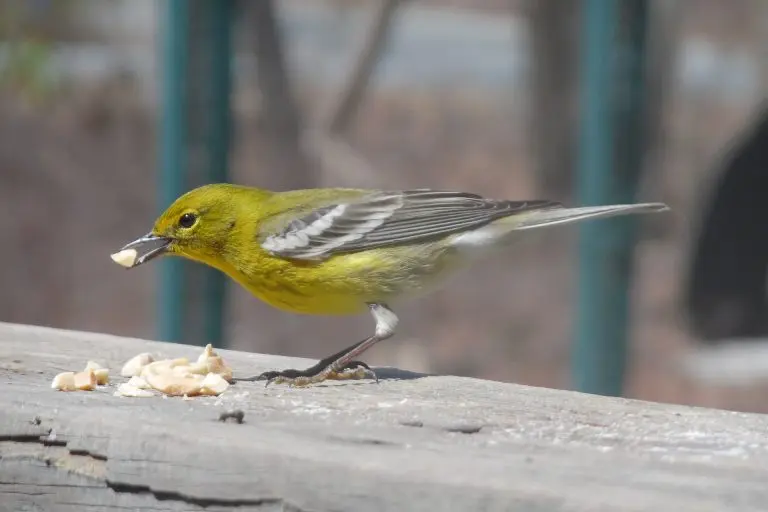
Pine Warblers are a year-round presence in Arkansas, featuring in 11% of both summer and winter checklists compiled by the state’s bird enthusiasts.
Characterized by their small, stout bodies, Pine Warblers sport a yellow hue with olive-toned backs, white undersides, and gray wing bars. Females may exhibit a browner appearance with more pronounced white on their bellies.
Setophaga pinus Length: 5.1-5.5 in (13-14 cm) Weight: 0.3-0.5 oz (9-15 g) Wingspan: 7.5-9.1 in (19-23 cm)
Pine Warblers, true to their name, favor pine forests for their habitat and can often be spotted high up in the trees. In terms of diet, they primarily feast on caterpillars, beetles, spiders, and other insects and their larvae. During colder periods, they shift their dietary preferences to include fruits and seeds.
To make your backyard more appealing to Pine Warblers, consider installing tube feeders and platform feeders stocked with millet, cracked corn, sunflower seeds, peanut hearts, and suet. Planting native fruits and vines, such as bayberry, grape, sumac, and Virginia creeper, can also help attract these charming birds.
